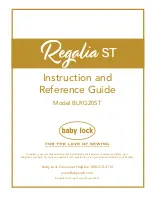
9
English
Stitch width
The normal stitch width setting for regular overlock
stitch is 5 mm (13/64 inch). To change the stitch
width, turn the stitch width adjustment dial.
$!
1
Increase the width to a maximum of 7.5 mm
(19/64 inch).
2
Reduce the stitch width to a minimum of 5 mm
(3/16 inch).
<A> Selection mark
Differential feed
IMPORTANT
- When sewing thick non-stretchable material
such as denim, do not use the differential feed
as it may damage the fabric.
This serger is equipped with two sets of feed
dogs under the presser foot to move the fabric
through the machine. The differential feed controls
the movement of both the front and the rear
feed dogs. When set at 1.0, the feed dogs are
moving at the same speed (ratio of 1.0). When
the differential feed ratio is set at less than 1.0,
the front feed dogs move slower than the rear
feed dogs, stretching the fabric as it is sewn. This
is effective on lightweight fabric that may pucker.
When the differential feed ratio is set at greater
than 1.0, the front feed dogs move faster than the
rear feed dogs, gathering the fabric as it is sewn.
This function assists in removing the rippling when
serging stretch fabrics.
Differential feed adjustment
Differential
feed ratio
Main
feed
(rear)
Differential
feed (front)
Effect
Application
0.7 - 1.0
Material is
pulled tight.
Prevents thin
materials
from
puckering
1.0
Without
differential
feed.
Normal
sewing
Differential
feed ratio
Main
feed
(rear)
Differential
feed (front)
Effect
Application
1.0 - 2.0
Material is
gathered
or pushed
together.
Prevents
stretch
materials
from
stretching or
puckering
The normal setting is 1.0 on the defferential feed
ratio adjustment dial.
To adjust the diffrerential feed, turn the dial on the
right bottom of the machine.
$!
1
Less than 1.0
2
Greater than 1.0 <A> Selection mark
To get smooth finish, adjust the feed ratio from 1.0
toward 2.0.
(The feed ratio required depends on the elasticity
of the material.)
The more elastic the material, the further toward
2.0 the differential feed ratio should be set. Test-
sew with a scrap of the fabric to find the correct
adjustment.
Adjusting the presser foot pressure
Turn the presser foot pressure adjustment screw
on the top left of the machine. You can adjust by
referring the value on the screw.
The normal setting is "2".
$!
1
Less pressure
2
More pressure
<A> Selection mark
Adjust the presser foot pressure to prevent the
material from puckering or to allow sewing of curves.
When sewing on very light materials, the presser
foot pressure should be loosened. When sewing
very heavy materials, the pressure foot pressure
should be tightened.












































